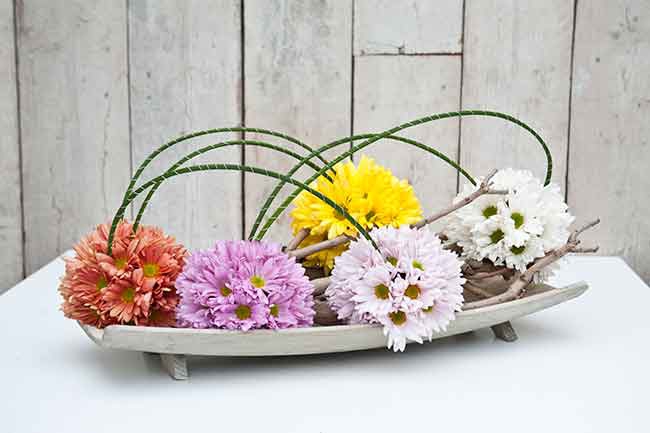
Features
Business
Trends
Cut Mums Make Great Bouquets
All in all, chrysanthemum is an intensive crop to cultivate, but rather easy to control, easy to plan production around, and it has a very large international market.
August 11, 2016 By Ori Danziger
 Cut mums are versatile in any arrangement…or by themselves.
Cut mums are versatile in any arrangement…or by themselves. September 2016 – Chrysanthemum belongs to the Compositea family and is a long-day, short-day plant, meaning that elongation occurs under long-day conditions and induction to flowering under short-day conditions.
At the end of each cycle, after harvest, plants are uprooted and the field prepared for the next planting. All in all, chrysanthemum is an intensive crop to cultivate, but rather easy to control, easy to plan production and with a very large international market. The chrysanthemum industry is enormous and among the 10 biggest crops commercially used worldwide.
Growing cycle – Each production cycle is made up of the long-day treatment stage, the short-day treatment stage, harvest and preparation of the field for the next planting.
Depending on local climate, market demand for stem length, and differences between varieties, three to more than five such cycles can be achieved in one year.
Uniformity of the cuttings and plants is highly important to allow a balanced resource management of the flower.
Planting density – Planting density differs between different varieties and climatic conditions. The common range is between 80 to 100 plants per gross square meter.
Cultivation – At mother stock stage, rooting and after planting, the long-day treatment is given by lighting the crop nightly so that plants are exposed to a total of 16 hours of light (including the daytime hours). Cyclic light systems can be used. No pinching is performed, so that each plant gives one high quality stem.
The period of long-day treatment depends on targeted stem length. Nowadays some varieties have minimal lighting requirements and can reach a stem length of 60 cm with no lighting at all. Long-day treatment is usually seven to 18 days.
Then the short-day treatment begins by shortening the day to 12 hours of light in a 24-hour period. In equatorial countries such as Colombia there is no need for short-day treatment. In four-season countries, when daylight is longer than 12 hours, total blackout is required in order to induce the flowering. The time span from initiating the “short-day treatment” to flowering is known as the “reaction time.” Each variety is characterized by its own reaction time, usually 6.5 to seven weeks. Flowers are harvested when just beginning to open and according to market preference, placed in water containing a bactericide, and ready for marketing.
Plant growth regulators – Plant growth regulators are used in order to get a strong stem and short pedicels with an abundance of buds. Apply one to three treatments and concentrations according to the growth habit of the various varieties.
Treatment for each variety is determined based on accumulated knowledge and growing conditions. Note that use of B9 can decrease the uptake of colour absorption due to cell walls hardening.
Plant protection – The main fungal disease to look out for is White Rust. The main pathogens are tomato spotted wilt virus (TSWV) and chrysanthemum stunt viroid (CSVd) that are transmitted via thrips. Among the pests, leaf miners are the most troublesome. Preventing insect or disease activity starts with vigilant scouting, monitoring and phytosanitary management.
Looking into the Future – Future chrysanthemums will have high tolerance to white rust like the Atlantis® series and will be resistant to virus and viroids.
Growing chrysanthemum will require less lighting, and varieties will have uniform flowering that will enable mechanical harvesting as is common in the Netherlands. This will allow a more efficient and cost-saving work method.
Danziger Varieties – In order to meet the ever-evolving demands of the dynamic floriculture market, Danziger puts great emphasis on the breeding of new varieties using both conventional and genetic engineering techniques. Our breeding aims at introducing early flowering varieties, with tolerance for both high and low temperatures and non-fading colour of the flowers. Our full range includes varieties of all types and colours.
Danziger “Dan” Flower Farm has been breeding and growing chrysanthemums for more than 40 years and offers a wide
selection of high-performing chrysanthemum varieties, led by the Atlantis series, known for its abundance of single/daisy perfectly shaped flowers, sturdy and stable stem, excellent vase life, high yield, ability to absorb colour efficiently, white rust resistance and use for all types of work from bouquets to designer arrangements. Danziger varieties are grown on high standard and professional farms in Colombia, destined for export to the North American market as well as the European market, the Far East and Russia.
The breeding team is focused on introducing new flower colours and shapes with favourable traits for the grower and end consumer. The Danziger Chrysanthemum collection is expanding yearly in compliance with the market requirement.
The company just recently introduced five new varieties, among them ‘Vino™’ and ‘Can Can™,’ which won second and third prize respectively at Colombia’s Proflora 2015 exhibition. Recently launched varieties include the yellow ‘Georgia™’ and ‘Cordelia™’ (which is characterized by its green centre), the white ‘Pana Cotta™’ and the pink ‘Cara Mia™.
Ori Danziger is regional sales manager for Latin America for Danziger “Dan” Flower Farm. He can be reached at ori@danziger.co.il.
Print this page